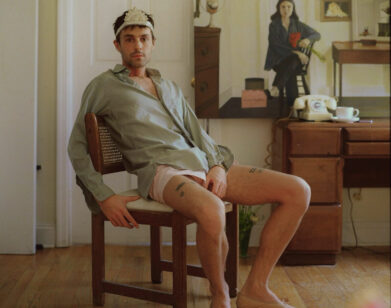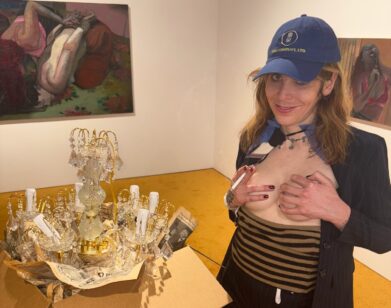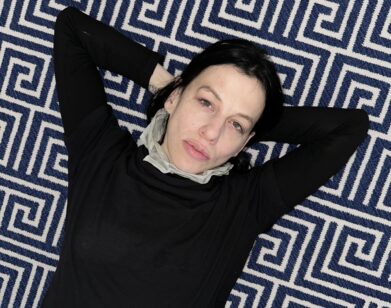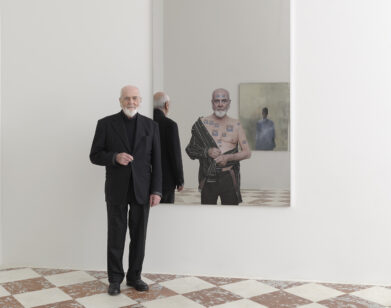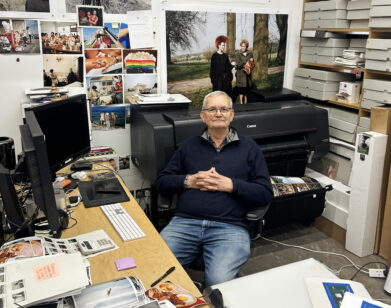Joe Bradley
I think you do kind of slip into a trance when you look at a painting. At least I do. Joe Bradley
Some ambitious young painters enter the New York art scene with an oil-slick branding approach to their styles: they see what’s popular and trademark their own variation of sloppy abstraction or psychological figuration, and in this way, become commercial arbiters, making small steps forward in the evolution of the canvas on walls. And then there are artists like Joe Bradley, the Maine-born quasi-abstractionist who seems to let the art scene flow around his Brooklyn Navy Yard studio without ever letting the current take him. Bradley, at age 38, has accomplished many things in his 13 years in New York—chief among them a staggering, almost chameleon-like range of styles and approaches to the practice of painting: monochromatic “modular” rectangles assembled in often anthropomorphic shapes; his Schmagoo Paintings series of basic, cave-like iconography (a cross, a fish, a stick man floating in space); black silhouettes of dancing figures marooned in white; and dense, chalky, abstract oil permutations, with pools of overlapping colors and shapes, merging with a dirty canvas backing.
Bradley, a father of two, possesses an ingenuous wonder of what paint can do, a sense of open-ended free play that energizes his work as well as haunts it with loaded double meanings. There is always the presence of the eternal line-maker, arm out, leaving a trace. His latest show, opening this month at Gavin Brown’s Enterprise, is titled “Lotus Beaters,” suggesting both a spiritual and drug-induced transcendence (with the art world, no doubt, willing lotus eaters).
In 2011, New York’s Museum of Modern Art acquired its first Bradley, an oil painting called Strut, which concerts vibrations of yellows, blues, and blacks in a haunting pathological primitivism. It was after the donation of that work that Bradley met Laura Hoptman, a curator in the museum’s Department of Painting and Sculpture, and it was at MoMA that they met to discuss what exactly is going on in the artist’s mind.—Christopher Bollen
LAURA HOPTMAN: This is Laura Hoptman and Joe Bradley on March 29th, 2013. We’re at the Museum of Modern Art in the Department of Painting and Sculpture. I’m asking questions and you’re answering them. [laughs]
JOE BRADLEY: Let’s do it.
HOPTMAN: So you’re from Maine, right?
BRADLEY: I grew up in Kittery Point, which is a small coastal town on the southern point of Maine.
HOPTMAN: What’s the first genuine artwork that you ever saw?
BRADLEY: In the flesh? God, I don’t know. I remember looking at books when I was in high school, but I don’t think I really stood in front of a genuine painting or sculpture until I was out of high school. Then sometimes I would go up to the museum in Portland—they had a few good things. I remember seeing an Alex Katz show there that left an impression when I was probably 18.
HOPTMAN: What about Andrew Wyeth, another Maine guy?
BRADLEY: I’d imagine they probably had some of that too.
HOPTMAN: When I think of Maine, I think of Winslow Homer, Andrew Wyeth, and Alex Katz.
BRADLEY: Marsden Hartley was also from Maine.
HOPTMAN: Jonathan Borofsky also lives in Maine now.
BRADLEY: Borofsky’s such an intriguing character. Didn’t he sort of drop out?
HOPTMAN: I think this idea of dropping out of the art world is interesting. It seems to be in the air lately. Someone wrote an article called “Can I Go Now?” [Frieze, March, 2013] recently about that.
BRADLEY: [laughs] A how-to? A Practical Guide to Leaving the Art World?
HOPTMAN: Well, there’s the physical way of leaving the art world, such as moving away from the center. But there’s also a psychological way to leave the art world. But I’m more interested in your entry rather than your putative exit someday.
BRADLEY: I went to the Rhode Island School of Design, and I was lucky enough to study with Dike Blair, who was a great mentor at school. He curated me into a group show in Allston, Massachusetts, in 2000. That was my first experience with exhibiting my work. I showed a group of small paintings.
HOPTMAN: So you’ve always been a painter, even though you’ve played around with the form?
BRADLEY: I’ve always been based in painting. I’ve sort of dabbled in installation and tried my hand at sculpture a couple of times, but it’s usually painting and drawing. I came to New York in 2000.
HOPTMAN: What did you envision your life would be like as a painter in New York City?
BRADLEY: I had no idea, really. I just imagined that I would have a little studio in the corner of my apartment. I had no expectations as far as showing. I was very naive when it came to how the art world functions. I was nervous about going to openings. [laughs]
HOPTMAN: You’re not any different from anyone else!
BRADLEY: It’s a very intimidating scene. But what I imagined is just what I did. I had a corner of my loft that served as my studio and I plugged away at these paintings. Kenny Schachter had seen the small paintings that I had shown in Allston, and he called up out of the blue and expressed interest. So he came over. He had a gallery, and that was my first show in New York. The work was already very different from what I had shown in Massachusetts. I worked at an antique store during the day and I would paint at night-or not paint at night. I went out a lot. And then a little while later I started showing at Canada gallery in Lower Manhattan.
HOPTMAN: And then you were invited to be in the 2008 Whitney Biennial.
BRADLEY: That came as a total surprise. It was a freakish sort of thing. I had done a show of those modular paintings in Los Angeles with Javier Perés.
HOPTMAN: Your monochrome canvases placed on the wall in the shapes of figures—sort of Pac Man-like figures.
BRADLEY: Yeah. I think the curators had seen that and it piqued their interest.
HOPTMAN: I find it interesting that your work is often put in the context of a very specific group of artists—male painters.
BRADLEY: Who do you think I’m lumped in with?
HOPTMAN: Well, I don’t agree with it. But I do admit that the first work I saw of yours was two canvases—one horizontal and one vertical—and I immediately thought, They are obviously a cock and balls, you know, in a cruciform pattern, an upside-down T. I thought it was hilarious.
BRADLEY: I have made a few cock paintings.
HOPTMAN: There was something great about it. But I didn’t see your work really again until you had a big solo show at Gavin Brown’s Enterprise in 2011. I remember thinking, I never would’ve thought that was the same guy! [laughs]
BRADLEY: Wait a minute—you didn’t tell me what gang of artists you think I’m lumped in with.
HOPTMAN: I know, I avoided that. I’ll just say this. It would be easy to say you make big, messy, quasi-abstract, super-good-looking paintings and pin you with other messy guy painters. But actually you are constantly changing your painting style. You’ve moved through a lot of different methods. Are these different strains, or are they all part of the same thing?
BRADLEY: It’s like skin, you know? The work all shares the same sort of DNA, but it just looks different. Do you understand what I mean?
HOPTMAN: Sure, because the same guy is painting each one.
BRADLEY: I always like being surprised and sort of caught off guard by other people’s work. So it doesn’t cause me any anxiety to explore different avenues.
HOPTMAN: Continuity in people’s work is important for the art historian because we look for “development,” in quotation marks—i.e., art history is an enlightenment discipline, and that means we chart history through comparisons and contrasts and also change things going forward, not backward.
BRADLEY: So it’s easy when there’s a neat, linear line of development.
HOPTMAN: Correct. So you go from, say, figuration toward the dissolution of the form, as with someone like Willem de Kooning. Then you get an artist like Picasso, who goes back and forth. But with Picasso, you could also chart very neat periods. He’s a civilization all to himself, right? He starts with his Neolithic period, he goes through his Classical period, then . . .
BRADLEY: Blue period, Rose period . . .
HOPTMAN: That’s right.
BRADLEY: At some point I realized that I had these ideas, and that I was self-censoring. When I was making the modular pieces, I was having ideas for artworks that didn’t really seem to relate directly, and I just wondered why I was doing that. I decided not to. [laughs]
HOPTMAN: That’s when you started your group of paintings that you call the Schmagoo Paintings—each with a different emblem drawn with a grease pencil.
BRADLEY: While I was making the modular paintings, I had this parallel studio activity of drawing, and those pieces were more free. Although those two bodies of work don’t superficially seem like they relate to each other, the material is the same, so it didn’t seem like a leap.
HOPTMAN: Where did the archetypal images from the Schmagoo Paintings come from? A stick figure, the fish in a mouth that looks like the vagina dentata, the horizontal line which can be the horizon line or a smile, the Superman logo. My favorite is Ecstasy [2009]. Are they gestalts? Or did you just let your brain do whatever it wanted?
BRADLEY: Some of them were lifted, like the Christ fish in the mouth of a larger fish. That one is sort of a direct lift from a Philip K. Dick drawing. In his Exegesis, he has these little sketches, and that was one I thought was really powerful. I was also on a Christ kick. Have you ever seen the movie Godspell [1973], where the Christ character is wearing a Superman T-shirt?
HOPTMAN: Some people thought they were similar to cave paintings. Have you ever been to the caves?
BRADLEY: No, I haven’t been to the caves.
HOPTMAN: Life changing. If there’s one thing you need to do, it’s go to the Périgord in Southern France to see those paintings, because it’s just unbelievable. It was like an electric connection to why I exist. The people at the dawn of civilization thought to leave a mark.
BRADLEY: Those first marks are like a template for everything that comes after, including the screens that we are staring into.
HOPTMAN: Precisely. You mentioned Philip K. Dick. Who else were you big on reading that influenced your work?
BRADLEY: I started reading Terrence McKenna around the same time as Dick. It’s really far-out. Discovering McKenna was pretty huge for me.
HOPTMAN: Fun fact. Genesis Breyer P-Orridge and Terrence McKenna both sent their kids to the same school in Northern California in the ’90s. I just love the idea that maybe Genesis and Terrence McKenna would pick their kids up from school. I picture them in a parking lot, talking and waiting for their kids.
BRADLEY: Two worlds colliding . . . [laughs]
HOPTMAN: Thinking of religion and the “psychonautic experience,” which is a term McKenna might have used about discovery in the mind, some artists use the materialistic qualities of a painting—the colors, the pigment, the cut and canvas—to excavate what makes a painting. Others are using it as more of a vehicle. From my early experiences with your works, I felt as if you were using painting as some sort of spaceship or vehicle to get somewhere. Am I mistaken?
BRADLEY: No, not at all. I think that painting relates very neatly to inner travel and the exploration of inner worlds. With painting, I always get the impression that you’re sort of entering into a shared space. There’s everyone who’s painted in the past, and everyone who is painting in the present.
HOPTMAN: A chat room.
BRADLEY: With dead people! [laughs]
HOPTMAN: So you see yourself as entering into this area, this dialogue, with the works that came before?
BRADLEY: Uh-huh.
HOPTMAN: It’s really about a conversation. It’s about looking at things synchronically—you look to your right, to your left, forward, back, and up and down as opposed to just forward or backward.
BRADLEY: I think that painting, in particular, with its long history, moves in that fashion. It’s not a forward, linear, sort of movement. You can be in conversation with those men and women in the caves—it’s like yesterday, you know? I think that time moves slower in painting. And maybe that accounts for a lot of the anxiety around painting in the last 40 or 50 years. You have the 20th century wrapping up and everything is moving at this breakneck speed? And then, painting is still walking. It’s just a very human activity that takes time.
HOPTMAN: It’s still a very primitive activity. You take a stick, you put some pigment on it, and then you scratch it on something.
BRADLEY: Yeah. And I think we’re at this very interesting point where that kind of activity, or even going and sitting down with your friend for a cup of coffee, feels sort of retro. So painting feels especially archaic.
HOPTMAN: It depends on the way we’re defining painting. Any two-dimensional object on a wall is considered painting. But you flirted with that definition with your modular monochromes.
BRADLEY: I hoped that those pieces had a sculptural presence, but without entering into sculpture. I love looking at sculpture, but there’s some sort of spell that’s broken with it. I think you do kind of slip into a trance when you look at a painting. At least I do.
HOPTMAN: How do you know when a painting is done?
BRADLEY: It’s a case-by-case, painting-by-painting scenario. I think it’s when it looks foreign to me, when I can’t unpack or retrace my steps into how the thing was made. That’s the only way—when you look at it and it looks like it came from somebody else.
HOPTMAN: You’re estranged from it. You once said that you can never let go of the figure. You always have a figure in your work so it’s never fully abstract. Why do you think that is?
BRADLEY: I guess I have no motivation to make an abstract painting, even if they sometimes read as abstract. I think, with abstraction, it’s easy to fall into a sort of pastiche.
HOPTMAN: A meaninglessness?
BRADLEY: Just to lean on the language of abstract painting too heavily. You see painters do that.
HOPTMAN: Art about art. Is sincerity a criteria for you? Is it one of the things you think about?
BRADLEY: I’m invested in these things, and I care about them, and I spend a lot of time trying to get them right. But painting can also be too earnest at times and that’s a drag. You don’t want to go in that direction either. It should be holistic. It should represent the whole of your personality, I guess, so if somebody is a sincere painter or an ironic painter, then they’re just bullshitting the audience and presenting only an idealized version of themselves.
HOPTMAN: I think there is a perpetual romance to painting and being a painter that never goes away. Although the way we use painting in culture always changes. I think we’re in a very interesting moment right now because there are two parallel worlds happening. The money, the speculation, the superstardom-all that crap-for some parts of our art world is not an issue. And yet, there are other parts of the art world where it’s a vital red center. So one part is promoting it and another part is trying to cut away the commercial connection that painting has always had around it. I find it tough. Do you ever feel politically incorrect because you’re a painter?
BRADLEY: Not really. I don’t really have much of a connection to that world, you know?
HOPTMAN: You don’t suit up and talk to collectors?
BRADLEY: Oh, I don’t know. The thing is that the money issue looms so large in art now. And it has absolutely nothing to do with art. If you’re painting goes for ten grand or a hundred grand, it doesn’t make painting any easier. And it doesn’t make the painting any better if it goes for a hundred grand. It’s just really beside the point and it’s a drag that there’s so much attention devoted to that.
HOPTMAN: People always tell me when I start complaining about it that it’s always been like that. There’s always been the money issue.
BRADLEY: The money thing seems to be just through the roof at the moment.
HOPTMAN: Also the way that it’s valued art in an existential way. It does a disservice to culture in general, because there are lots of things that people don’t want that might very well be something we need. The more difficult truths might not be much in the general circulation. That’s what museums are for, that we get to exhibit everything. What was it like to be acquired by the Museum of Modern Art?
BRADLEY: That was a total thrill. For the obvious reason it’s just exciting to be included in that collection.
HOPTMAN: Is it because lots of people will see it?
BRADLEY: That’s exciting. When I got the call, I just stared out the window for 45 minutes. And I’m not the kind of person, I don’t really get excited about good things happening to me. That was a big deal. For sure.
HOPTMAN: Yeah, me too. It’s like a temple here. I like working here because it’s a big deal. It means something. When you go to galleries and visit studios today, do you tend to see more things that you like than you dislike?
BRADLEY: When I was younger I was very opinionated about art. And then, I realized that I kind of recognized this pattern where the things that I was vehemently of pissed off about, I would end up loving them two years later. So I just tried to mellow out. Like there’s art that I think is pretty silly, but it doesn’t get under my skin like it used to. But Chelsea does feel particularly bloodless at the moment.
HOPTMAN: I think there’s an opportunity for museums now, to be able to step up and use our great collections and our scholarship to do something interesting vis-à-vis contemporary art and the general public that can’t be done in galleries. No matter how big the galleries are—and how brilliant a lot of the gallerists are—museums have the advantage that they don’t have to pander to an art-buying public. We’re not selling anything, so we can show the kinds of work that isn’t easily sellable. We can also take works of art that are well known and put them into a context that makes the audience see it in a different way.
BRADLEY: I agree. Although, that being said, I’ve always liked the fact that galleries are free to visit in New York. When I first moved to New York, I didn’t have any money. That was the only thing I could afford to do. [laughs] You can’t go to the movies. So even though there are some lucky guys who are buying this stuff, it is nice that it’s free to the public and that it’s open for peer-review, and whoever wants to stumble in can stumble in.
HOPTMAN: When you were growing up in Maine, did you have art in your house?
BRADLEY: No. Aside from like Norman Rockwell prints and that sort of thing.
HOPTMAN: That counts. I think that makes a big difference. Not everybody has stuff on the walls. I think it’s important to encourage a culture of putting things on the wall. Not just for people to make their houses more beautiful, but their lives more beautiful. Put more windows in your house by buying paintings.
BRADLEY: When there’s a painting in the room, my eye goes right to it. It’s like if you go into a bar and there’s a television on, you can’t take your eyes off the television. Paintings have that effect on me. It’s where my eye settles. So I guess having anything on the wall can kind of kick off that habit.
LAURA HOPTMAN IS A CURATOR IN THE DEPARTMENT OF PAINTING AND SCULPTURE AT THE MUSEUM OF MODERN ART.


